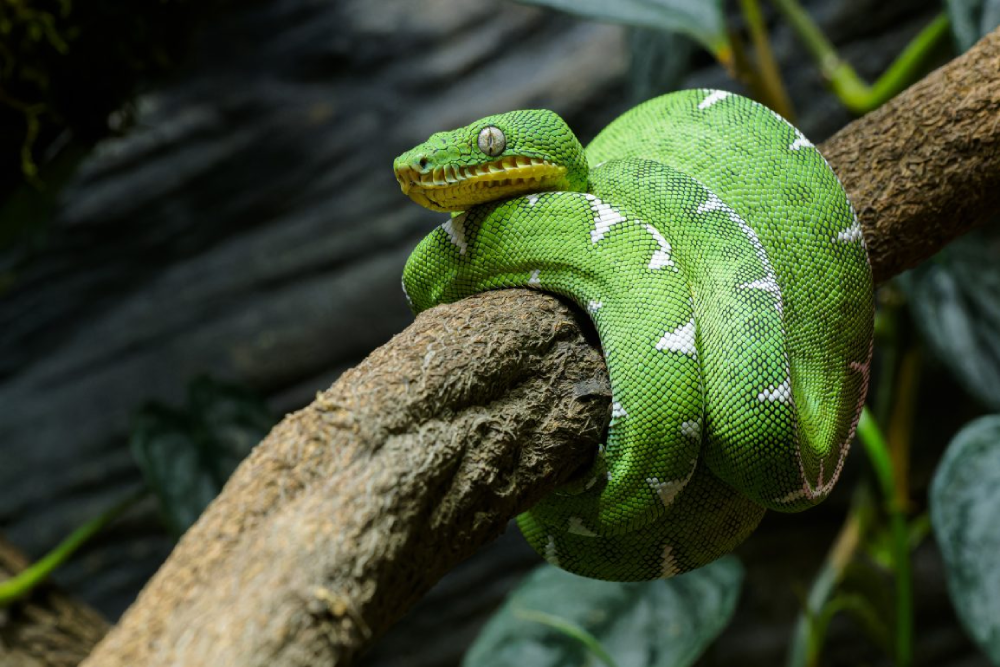Introduction: In the shadowy depths of the South American rainforests, amidst the lush canopy and dense foliage, slithers a creature of unparalleled beauty and mystery—the Emerald Tree Boa (Corallus caninus). With its vibrant green scales glistening like precious gemstones against the backdrop of emerald-hued leaves, this serpent commands attention and admiration from all who encounter it. In this article, we delve into the fascinating world of the Emerald Tree Boa, exploring its physical characteristics, habitat, behavior, and the unique role it plays in its ecosystem.
Physical Characteristics
One cannot help but be captivated by the striking appearance of the Emerald Tree Boa. Its most distinctive feature is, undoubtedly, its vibrant green coloration, which serves as impeccable camouflage amidst the verdant foliage of its rainforest habitat. This coloration is not only aesthetically pleasing but also functional, allowing the boa to blend seamlessly into its surroundings and evade potential predators.
However, what truly sets the Emerald Tree Boa apart are its remarkable eyes. Sporting large, forward-facing eyes with vertical pupils, this serpent possesses exceptional binocular vision—a trait uncommon among snakes. This adaptation enables it to accurately gauge distances and accurately strike at its prey, which primarily consists of small mammals, birds, and occasionally, reptiles.
The Emerald Tree Boa’s body has a series of intricate markings and patterns, which vary in intensity and shape among individuals. These markings often consist of irregular blotches or speckles of contrasting colors, such as yellow or white, creating a mesmerizing mosaic along the snake’s dorsal surface.
Habitat and Distribution
The Emerald Tree Boa is indigenous to the rainforests of South America, where it resides primarily in the canopy layer of dense, tropical forests. Its range extends across several countries, including Brazil, Colombia, Venezuela, and parts of the Guianas. Within these regions, the boa occupies a variety of habitats, from lowland rainforests to montane cloud forests, demonstrating remarkable adaptability to diverse environmental conditions.
Within its chosen habitat, the Emerald Tree Boa displays a strong preference for areas with abundant vegetation and tall trees, where it can ambush unsuspecting prey from elevated vantage points. Despite its arboreal lifestyle, this species occasionally descends to the forest floor, particularly during periods of shedding or to seek out water sources.

Behavior and Reproduction
As primarily nocturnal predators, Emerald Tree Boas spend much of their daylight hours coiled among the branches of trees, where they remain hidden from view. When night falls, however, these serpents become active hunters, utilizing their keen senses to locate prey items such as rodents, birds, and bats.
One of the most fascinating aspects of Emerald Tree Boa behavior is its reproductive strategy. Like many snakes, this species is ovoviviparous, meaning that females give birth to live young rather than laying eggs. After a gestation period of approximately six to seven months, females typically produce a litter of 10 to 20 neonates, each measuring around 18 to 24 inches in length. These miniature replicas of their parents are equipped with all the necessary instincts for survival and often disperse into the surrounding forest shortly after birth.
Conservation Status and Threats
Despite its remarkable beauty and ecological significance, the Emerald Tree Boa faces numerous threats to its continued existence. Habitat destruction, primarily through deforestation and land conversion for agriculture, poses one of the most significant challenges to this species. As vast tracts of rainforest are cleared, the boa’s natural habitat dwindles, leaving it increasingly vulnerable to extinction.
Additionally, the illegal pet trade represents another significant threat to the Emerald Tree Boa. Due to its striking appearance and relative rarity in captivity, collectors and enthusiasts around the world pay much attention to them. Unregulated collection from the wild not only decimates wild populations but also disrupts ecosystem dynamics and genetic diversity.
Efforts to conserve the Emerald Tree Boa and its habitat are underway, albeit with varying degrees of success. Conservation organizations and governmental agencies are working to establish protected areas, enforce legislation against illegal trade, and raise awareness about the importance of preserving rainforest ecosystems.
Conclusion
In conclusion, the Emerald Tree Boa stands as a testament to the intricate beauty and complexity of the natural world. From its dazzling green scales to its enigmatic behavior, this serpent captivates the imagination and inspires awe in all who encounter it. As stewards of our planet, it is incumbent upon us to protect and preserve this magnificent species, ensuring that future generations may continue to marvel at its elegance and grace amidst the emerald-hued canopy of the South American rainforest.









